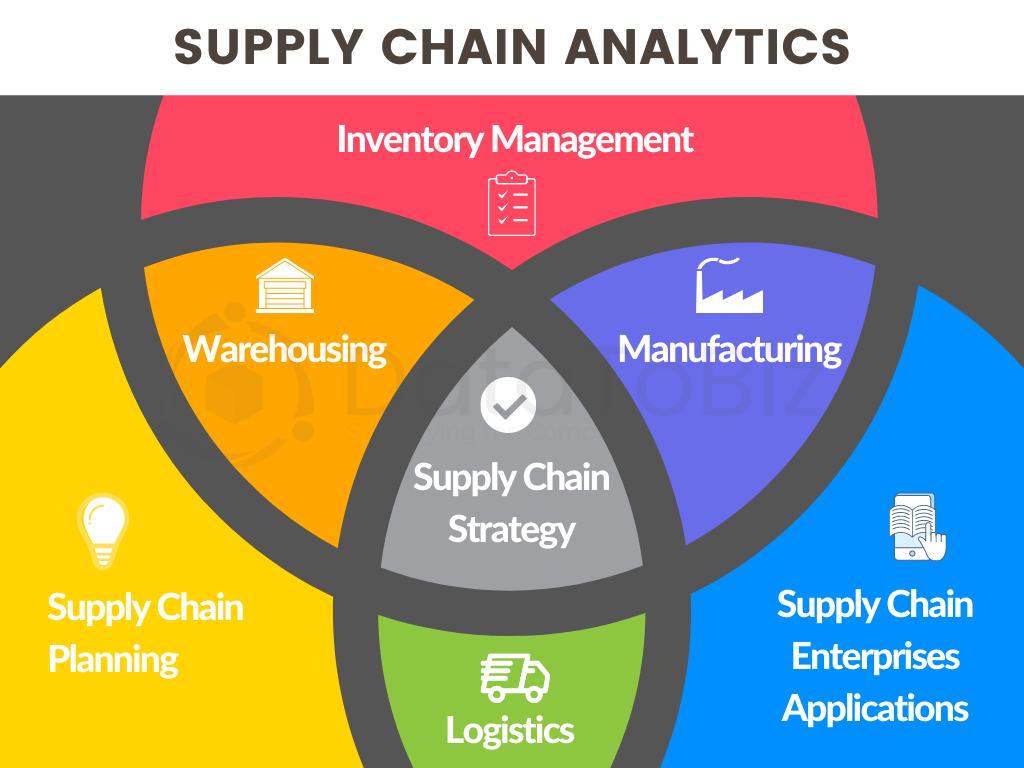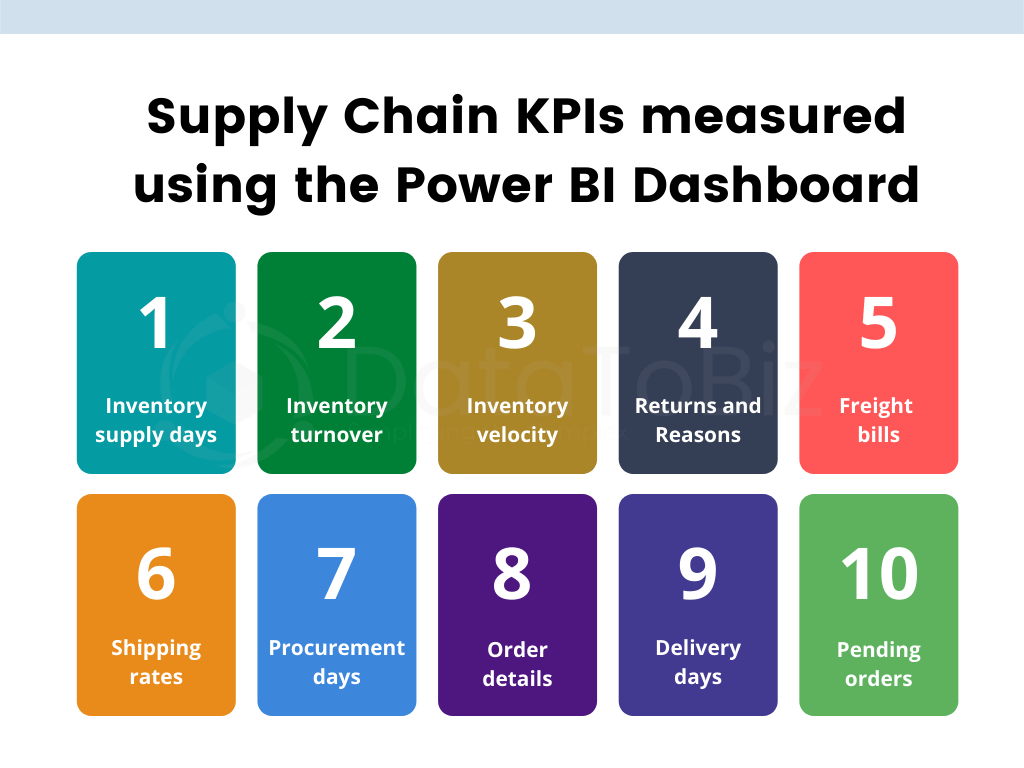Supply chain analytics helps businesses understand their datasets to make informed decisions about their logistics and transportation processes. Power BI is an incredibly useful business intelligence tool to create supply chain dashboards and use the insights in real-time. Let’s discuss the role of supply chain analytics and Power BI in various industries.
The supply chain is a network of people, businesses, and processes that ensure that a company continues to produce and sell products/ services in the market. From sourcing raw materials to moving finished goods to the warehouse and delivering them to the end customers, the supply chain network is intricate, complex, and systematic.
The implementation of the supply chain strategy has an impact on the success of a business. After all, how can a company deliver the products/services to the end-users if it cannot source the materials or transport the finished goods as per the schedule?
Covid-19 has disrupted the global supply chain, and the Middle Eastern markets, too, faced the same trouble. Challenges such as shortage of labor due to lockdowns, increase in demand, and reduction in supply and adhering to the safety protocol makes it difficult for businesses to manage their supply chain. However, the companies also know a solution to the problem.
Many Middle Eastern businesses are heavily investing in technology, especially artificial intelligence, to make their supply chains more resilient even in adverse conditions. For example, Hypermotion Dubai is an ME edition of the German-initiated convex that gives the transportation and logistics industries a fresh start. The aim is to be sure that the emirate continues to lead in supply chain management and speed up development.
The Dubai-based global logistics company, Aramex, has built a data lake and streamlined its supply chain process by relying on machine learning. This led to a whopping 74% increase in shipping accuracy. It also resulted in a 40% reduction of calls to customer support. Middle Eastern companies know that digitalization is the way to the future. Business intelligence for the supply chain is becoming an integral part of various companies.
But what is supply chain business intelligence? How does it help the companies, and which BI tools can be used to build a supply chain dashboard?
Supply chain analytics is the analysis of the individual elements of the supply chain that work together to help the business achieve its goals. Procurement, inventory, warehouse, order management, shipping, and deliveries are the elements of the supply chain.
Understanding how every element contributes to keeping the supply chain running will help businesses overcome roadblocks and prevent delays. While there are various software applications to manage individual elements, companies need to bring it all together on a single platform/dashboard. This makes it easier to identify the correlations and come up with the necessary solutions.

The following are the four major types of supply chain analytics that help enterprises improve the efficiency of their business operations, streamline logistics, and save time and money without compromising quality.
Key challenges that Supply chain analytics solution solves:
Struggling to reap the right kind of insights from your business data? Get expert tips, latest trends, insights, case studies, recommendations and more in your inbox.
Companies use analytics to process and analyze the data generated at different points in the supply chain. The logistics dashboard empowers companies to stay up to date and get real-time information about their supply chain processes. It gives them the information to make last-minute changes and make decisions based on historical and real-time information. Managing local, national, and global supply chains is simpler when using supply chain analytics.
Businesses need to invest in building supply chain dashboards to make the most of data analytics. Since companies don’t often have in-house teams to manage business intelligence, they hire offshore solution providers to create the BI dashboards. Many AI service providers recommend Power BI for supply chain analytics. Power BI is a Microsoft product that helps build business intelligence dashboards for various business requirements.
Power BI experts help business enterprises use supply chain analytics to transform their business in the following ways:
Accurate forecasting can reduce the uncertainties in inventory and warehouse management. Analyzing customer preferences, purchase history, market trends, and the inventory at different distribution centers will help businesses plan the stock in their inventory to keep up with the customers’ requirements. It is one of the most vital supply chain management techniques.
Knowing which products have a higher demand and anticipating the changes in the market conditions will increase sales for the business. Supply chain analytics gives the management the necessary insights about the demand and supply ratio for their products. Releasing products into the market at the right time will give the business a better chance to capture the customer base.
The quality standards here pertain to the logistics and supply chain processes. For example, the Power BI logistics dashboard will make it easy to identify the gaps in the supply chain that are causing disruptions in procurement or deliveries. By rectifying the gaps, the business increases the quality standards of the process and gets higher returns.
How a business uses the supply chain dataset determines whether it can achieve its goals or not. Big data solutions facilitate businesses to better understand the changing demands in the market. Not only does supply chain analytics use historical data, but it also processes real-time information from multiple sources to increase the accuracy of the forecasts/predictive insights. Supply chain analytics makes businesses proactive instead of reactive.
Power BI is a popular business intelligence tool used by enterprises of all sizes and volumes. Multiple dashboards can be created for each department to provide employees access to the centralized data sets and the derived insights. Supply chain analytics using Power BI improves functional efficiency and aligns the processes to suit the changes in customers’ demands and market trends.
Here’s how the supply chain dashboard in Power BI helps businesses from several industries to streamline their in-house and third-party logistics/ transportation processes.
Internal and external data related to the business are collected and stored in a central database. From suppliers’ information to customer preferences, the datasets contain a huge volume of historical and real-time information. The managers will know if a supplier hasn’t been providing raw materials on time or how the prices have increased over the years.
Power BI makes it easy to integrate data from all parts of the business and display the relevant information on a single dashboard. Employees don’t have to put up requests to access data. They can directly use the dashboard to gather what they need for decision-making. For example, the information about the stock left in the inventory can be found in real-time by clicking on the related component in the dashboard.
Power BI dashboards are customized to meet the business requirements and allow employees to access insights at the micro and macro level. The filters/ components of the dashboard can be added or deleted using the drag and drop feature. Say, an employee needs to know more about the orders received during the last month. They can change the filters to get a graphical representation of the number of orders, the quantity, the demographics of customers, delivery dates, and so on.
A few KPIs measured using the Power BI dashboard are:

The elements of the supply chain are interconnected and rely on each other to create a seamless end-to-end path from procurement to delivery. The supply chain Power BI dashboard helps businesses manage all four areas from one place.
The role of the Power BI supply chain dashboard in business enterprises is to help employees, managers, and C-Suite executives to make day-to-day and long-term decisions to improve their supply chain processes. Hiring offshore Power BI services will empower the business to optimize logistics and achieve long-term goals and gain an edge over the competitors. Understanding data correctly will reduce the risk of error and losses. Talk to our Microsoft Power BI developer to know more.
